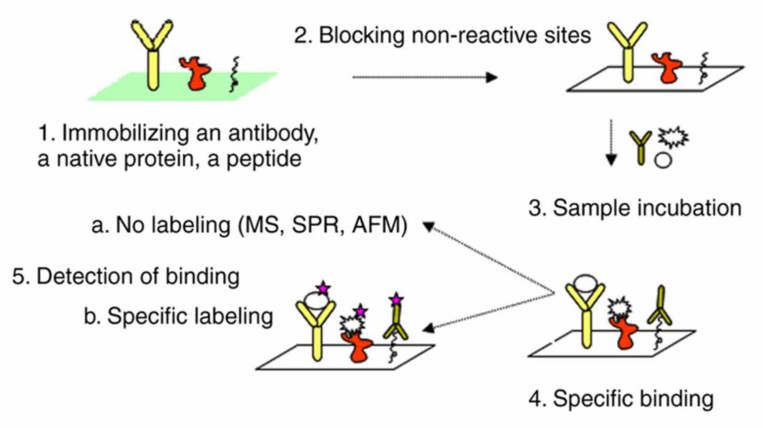Antibody microarray is a kind of protein microarray with miniaturization, integration and high throughput, which can be used to detect the expression abundance of proteins related to a specific physiological or pathological process, mainly for signal transduction, proteomics, tumor and other disease-related research.
As an international leading supplier of protein microarray, Creative Proteomics has the world's largest variety of antibody microarray, which can be used to detect the expression abundance of proteins related to biological physiology or pathological processes, screen disease markers, explore the mechanism of drug action, and detect signaling pathways, etc.
Its products have high detection sensitivity and various detection species, including humans, mice, rats, pigs, horses, cattle, monkeys, dogs, cats, rabbits and other species. Samples that can be tested include cultured cells, cell culture supernatants, serum, plasma, frozen tissue, formalin- or Trizol-soaked tissue, and paraffin-embedded tissue and sections.
Our Antibody Array Features
4 technical replicates of each antibody on the antibody array.
Each antibody array can quantify 8-10 samples.
It can effectively detect micro-indicators with a lower limit of 1 pg/mL.
Thousands of cytokines can be detected in 50 μL of liquid sample and 200 μg of total protein.
It is suitable for a wide range of biological samples such as serum/plasma, culture supernatant, cells and tissue lysate.
It can avoid the batch-to-batch errors introduced by traditional methods.
Expand the amount of information in a single sample and allow for cross-analysis between different analytes.
Our Product List
If the product you need is not in the list below, please contact us
Protein Phosphorylation Antibody Microarrays
Antibody Microarrays for Protein Expression Levels Detection
Antibody Array for Quantitative Detection of Cytokines
Principles of Antibody Array
Multiple antibodies that bind specifically to different antigens are immobilized at high density onto slides or other carriers, allowing the sample to be tested to pass over the surface of the array, and the non-specifically bound proteins are removed by elution, thereby detecting the specifically bound antigens.
 Workflow of antibody microarray analysis
Workflow of antibody microarray analysis
Role of Antibody Microarrays
Protein expression profiling: It can detect the protein expression profile of one sample or the relative difference in protein expression levels between two different samples. Hundreds (up to 500) of protein expression levels can be compared in a single experiment. The sample can be a protein extracted from a cell, tissue or body fluid, or a total protein, cytoplasmic protein, nuclear protein or an organelle protein.
Detection of changes in phosphorylation levels: A rapid screening of proteins with altered phosphorylation levels can be performed from hundreds of known proteins. Protein phosphorylation is a major type of post-translational processing that involves many important cellular functions, and is a biomarker of altered protein activity, which is important in signal transduction studies.
Protein interaction detection: antibody microarrays are used to detect the presence of interactions between a protein and various proteins on the chip. For example, when studying the function of a new gene and its encoded protein, it is necessary to identify the interaction between the new protein and other known proteins.
Applications of Antibody Microarrays
The main applications of antibody microarray technology are to discover new protein functions, understand the molecular mechanisms of protein function, analyze the signaling pathways stimulated by specific stimuli, screen drug candidate molecules, and discover new tumor biomarkers.
a) Application of antibody microarrays in the study of tumors and other diseases
Certain proteins with up- or down-regulated expression levels and altered activity in patients may be used for disease diagnosis, monitoring, efficacy evaluation or as target molecules for therapy. Therefore, antibody microarrays are important in studying disease development, finding disease biomarkers and selecting new therapeutic targets.
b) Application of antibody microarrays in signal transduction research
There are various signal transduction pathways in cells, and there are complex interactions among them, so a comprehensive and systematic study of signal transduction requires the use of high-throughput technology.
Antibody microarray technology can not only detect the expression of various signaling proteins, but also analyze the interaction between multiple proteins and proteins simultaneously, which is very suitable for deducing molecular networks and signal transduction pathways.
c) Application of antibody microarrays in proteomics
There are two main technical routes for proteomics research: one is by two-dimensional electrophoresis and mass spectrometry; the other is by antibody microarrays.
Wingren et al. immobilized thousands of recombinant antibodies on microarrays and combined them with biological samples to be measured, such as the whole proteome, the resulting microarray pattern can be transformed into a proteome map or molecular fingerprint, which can reveal the constituent components of the proteome.
* This product is For Research Use Only. Do Not use in diagnostic or therapeutic procedures.

 Workflow of antibody microarray analysis
Workflow of antibody microarray analysis